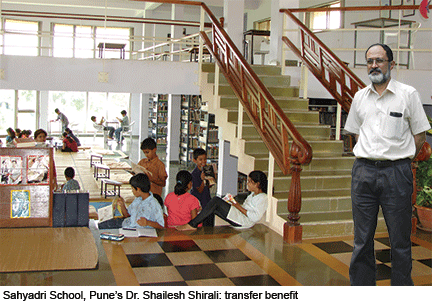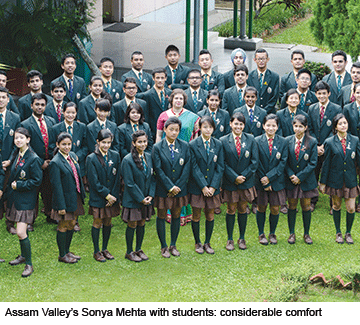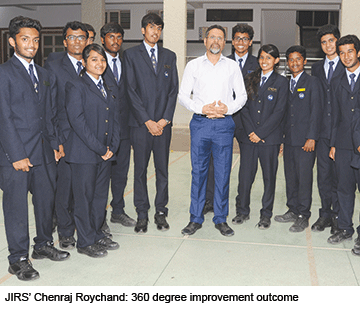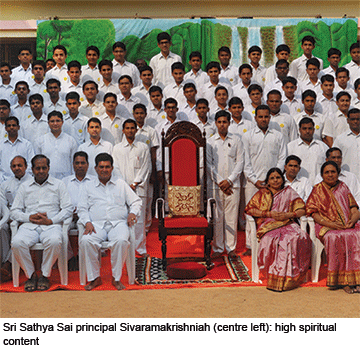A good augury for the future of gender relations in Indian society which has acquired a globally notorious reputation for gender atrocities, is that the great majority of post-liberalisation boarding schools are co-educational
 A beneficial legacy of almost 200 years of British raj in India which has survived the test of time, are the few hundred boarding schools, some of whom boast their lineage and traditions stretching over two centuries. And if India’s legacy boarding schools have endured despite the global post-World War II — especially American — trend of sending children to primary-secondary day schools, it’s because these boys, girls and co-ed boarding schools have adapted to the new temper and times of post-independence India and metamorphosed into excellent providers of holistic education with a balanced emphasis on scholastics, performing arts and sports education. Moreover, with India’s overcrowded 7,900 towns and cities transforming into chaotic, pollution-intensive sink-holes, traditional boarding schools usually sited in scenic hill stations or carefully selected pollution-free environments, and generally more affordable than new genre international schools, are beginning to find favour once again with the country’s fast-expanding middle class.
A beneficial legacy of almost 200 years of British raj in India which has survived the test of time, are the few hundred boarding schools, some of whom boast their lineage and traditions stretching over two centuries. And if India’s legacy boarding schools have endured despite the global post-World War II — especially American — trend of sending children to primary-secondary day schools, it’s because these boys, girls and co-ed boarding schools have adapted to the new temper and times of post-independence India and metamorphosed into excellent providers of holistic education with a balanced emphasis on scholastics, performing arts and sports education. Moreover, with India’s overcrowded 7,900 towns and cities transforming into chaotic, pollution-intensive sink-holes, traditional boarding schools usually sited in scenic hill stations or carefully selected pollution-free environments, and generally more affordable than new genre international schools, are beginning to find favour once again with the country’s fast-expanding middle class.
A good augury for the future of improved gender relations in Indian society, which with incremental neglect and lumpenisation of K-12 education has acquired a globally notorious reputation for gender atrocities, is that the great majority of post-liberalisation boarding schools are co-educational. With single-sex boarding schools gradually becoming unfashionable and boys and girls residing, learning and playing in egalitarian education institutions, there’s a strong likelihood that they will develop sentiments of gender sensitivity and mutual respect in their formative years.
Be that as it may, in the largest segment of traditional/legacy boarding schools, there has been a change in seating arrangements at the top table. The four-year reign of the alternative/new age Rishi Valley School, Chittoor (Andhra Pradesh), founded by education savant J. Krishnamurti (1895-1986) in 1931, as India’s most preferred co-ed boarding school, has ended. Ironically, the usurper is another recent vintage KFI (Krishnamurti Foundation of India)-supported primary-secondary, viz, Sahyadri School, Rajgurunagar, 70 km from Pune, Maharashtra. These two new-age wholly residential KFI schools have pushed the vintage Lawrence School, Sanawar (estb. 1847) ranked # 2 in 2013 to a joint #3 with yet another new age primary-secondary, the Rajghat Besant School, Varanasi. Further down, the Chinmaya International School, Coimbatore (#14) has pushed the Assam Valley School, Balipara — Eastern India’s #1 co-ed boarding school — to #5, a ranking it shares with the Bangalore-based Jain International Residential School.
 The surprising emergence of the low-profile CISCE-affiliated Sahyadri School (estb. 1995) as the #1 co-ed boarding school is to a significant extent attributable to the transfer of Dr. Shailesh Shirali, principal of the Rishi Valley School (RVS) for over two decades, to take charge at Sahyadri in 2012. Quite obviously, Shirali has implemented the best practices which transformed Rishi Valley into the country’s most preferred boarding school, in his new charge.
The surprising emergence of the low-profile CISCE-affiliated Sahyadri School (estb. 1995) as the #1 co-ed boarding school is to a significant extent attributable to the transfer of Dr. Shailesh Shirali, principal of the Rishi Valley School (RVS) for over two decades, to take charge at Sahyadri in 2012. Quite obviously, Shirali has implemented the best practices which transformed Rishi Valley into the country’s most preferred boarding school, in his new charge.
“As you are well aware, in KFI-supported schools we don’t attach much importance to rankings and league tables. However it’s encouraging to learn that your sample respondents are appreciative of our efforts to educate children beyond preparing them for employment. In KFI schools, our objective is to make students aware of larger socio-economic issues including environment and ecology preservation, and prepare them for the increasingly complex workplaces of the 21st century. It’s encouraging to learn that a rising number of informed stakeholders in school education are beginning to share our perspective,” says Shirali, an operations research Ph D of Texas University who taught mathematics at Rishi Valley for over two decades — during which he authored several textbooks on the subject — before being appointed principal of RVS in 1992 and of the Sahyadri School in 2012.
The new seating arrangement at the Top 10 table has “somewhat disappointed” Sonya Mehta who took charge as head of school at the superbly-equipped Assam Valley School (AVS) late last year following the resignation of Derek Mountford, who during the decade he was headmaster of AVS (2003-2013), shaped it into one of the country’s Top 3 co-ed boarding schools and #1 in eastern India. Nevertheless Mehta, an alumna of St. Xavier’s, Mumbai, SNDT and San Diego universities and former teacher at The Shri Ram schools at Moulsari and Aravali and Indus International, Bangalore (2004-13), is inclined to derive considerable comfort from AVS’ Top 5 ranking despite the upheaval following Mountford’s resignation, a flight of loyalist teachers, and the adverse publicity that the north-east states routinely receive for political instability and civic disturbances.
“I am pleased to learn that AVS’ reputation for providing the best infrastructure and sports facilities has been confirmed by the latest EW survey. Our academic results are excellent and AVS is ranked among the Top 10 CISCE-affiliated schools countrywide for our ISC (class XII) results. There’s growing recognition within the public that AVS provides its students excellent holistic, and valuable life skills education. However the new-age schools which dominate the rankings this year are doing a lot of things right. I’m sure we can learn from them,” says Mehta.
 A similar emphasis on providing its 725 students of both sexes with awesome infrastructure and sports facilities is discernible in the new millennium CBSE, CIE and IBO (Geneva)-affiliated Bangalore-based Jain International Residential School (JIRS, estb. 2000). Among the cognoscenti in the K-12 education space, JIRS has acquired an awesome reputation for its infrastructure and sports facilities.
A similar emphasis on providing its 725 students of both sexes with awesome infrastructure and sports facilities is discernible in the new millennium CBSE, CIE and IBO (Geneva)-affiliated Bangalore-based Jain International Residential School (JIRS, estb. 2000). Among the cognoscenti in the K-12 education space, JIRS has acquired an awesome reputation for its infrastructure and sports facilities.
According to Chenraj Roychand, a class VII dropout who took to the entrepreneurial path at age 16 and became the largest Reliance textiles dealer in peninsular India with 365 franchisees before he ventured into education and promoted the Sri Bhagawan Mahaveer Jain College, Bangalore in 1990, JIRS, spread over 150 acres, offers its students the services of 50 professional coaches in 13 sports including cricket (five grounds), football (three grounds), tennis and squash (24 courts), table tennis (100 tables), swimming (three pools) and indoor games (two stadia). “Our academic results are also excellent. There’s been a 360 degree improvement across all the EW parameters. This is the explanation for our substantially improved ranking this year,” says Roychand.
The most spectacular entry into the Top 10 table of co-ed boarding schools is of the CBSE-affiliated Sri Sathya Sai Higher Secondary School (SSSHSS, estb.1983) sited on the massive Prasanthi Nilayam campus township established by the late philanthropic sage and divinity Sri Sathya Sai Baba (1996-2011) in Anantpur district of Andhra Pradesh. Currently, this tuition-fees-free class I-XII residential (hostel fees: Rs. 1,500 per month) school has 1,183 children including 470 girl students instructed by 85 teachers on its muster rolls. Moreover, in the academic year 2013-14, the school recorded excellent results in the CBSE class XII school-leaving exam to be ranked #7 nationwide with its cohort of 114 students averaging 90 percent (see CBSE Top 100).
 “SSSHSS is a unique institution founded by the late Bhagwan Sai Baba to provide free-of-charge primary-secondary education with high spiritual content to children of all castes, creeds and communities. Over the past 31 years, this school has acquired an excellent reputation in Andhra Pradesh and South India for its academic, co-curricular and sports education. Because of our emphasis on spiritual content including yoga and meditation, our students are also highly appreciated for their life and conflict management skills,” says Y. Sivaramakrishniah, a former chemistry professor at the Hindu College, Guntur who signed up as a teacher at SSSHSS in 1979 and was appointed principal in 1991. Unsurprisingly, the school receives over 70 admission applications per vacant seat for classes I and XI every year and admissions are by lottery.
“SSSHSS is a unique institution founded by the late Bhagwan Sai Baba to provide free-of-charge primary-secondary education with high spiritual content to children of all castes, creeds and communities. Over the past 31 years, this school has acquired an excellent reputation in Andhra Pradesh and South India for its academic, co-curricular and sports education. Because of our emphasis on spiritual content including yoga and meditation, our students are also highly appreciated for their life and conflict management skills,” says Y. Sivaramakrishniah, a former chemistry professor at the Hindu College, Guntur who signed up as a teacher at SSSHSS in 1979 and was appointed principal in 1991. Unsurprisingly, the school receives over 70 admission applications per vacant seat for classes I and XI every year and admissions are by lottery.
Further down the co-ed boarding schools league table, the Lawrence School, Lovedale and Pinegrove School, Dharampur (1991) which advanced substantially last year, have maintained their joint #10 rank in 2014. Moreover, the Moti Lal Nehru School of Sports, Sonipat, ranked #19 in 2013, has improved its ranking to #14 this year and the Sagar School, Alwar from #26 to 25.
To see Co-ed Boarding Schools all-India ranking visit http://www.educationworld.in/rank-school/all-cities/boarding-school/co-ed/2014.html